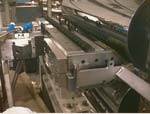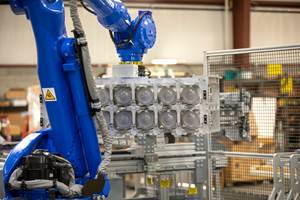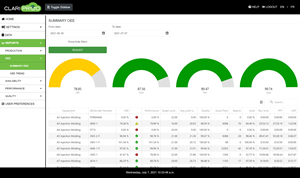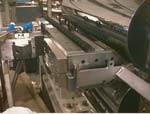SPI revises extrusion, injection molding automation safety standards
Advances in technology, particularly controls, have prompted SPI to update some machinery safety standards.
Safety standards covering elements of sheet extrusion and the use of automation with injection molding have been revised, updating guidelines last modified in 1999 and 2003, respectively, in a bid to keep pace with evolving technologies. The Society of the Plastics Industry (SPI), which announced the revisions in conjunction with the American National Standards Institute (ANSI), called the changes “significant and substantive.”
Dave Felinski, SPI’s Standards Program Coordinator, told Plastics Technology that both updates were meant to address advances to safeguarding devices and controls since the standards were originally written.
Felinski said that while the Occupational Safety and Health Administration (OSHA) was not directly involved in the development of either standard, both were “developed to ensure there were no conflicts with OSHA regulations which are minimum requirements.”
ANSI/SPI B151.20 – 2013, Safety Requirements for Plastics Sheet Production Machinery, updates the latest concepts in general machine safety specifically applied to sheet production machinery, according to Felinski.
“Perhaps the most significant addition is the incorporation of risk assessment and risk reduction principles in the design and construction as well as user sections of the standard,” Felinski said.
ANSI/SPI B151.27 – 2013, Safety Requirements for the Integration of Robots with Injection Molding Machines, also seeks to address advances to safeguarding devices and controls, according to Felinski.
“More importantly the revisions to B151.27 include additional requirements while teaching within perimeter guarding,” Felinski said, adding that they also address resetting perimeter safeguarding devices.
“The B151.27 standard has updated requirements in the area of risk assessment and risk reduction, consistent with the recent ANSI machinery safety standards dealing with those concepts, and far more current than the ISO standard on those principles,” Felinski explained.
Injuries, fatalities on the decline
Except for 2011, the accident incident rate in the U.S. has shown “statistically significant declines” for the last decade, according to the Bureau of Labor Statistics. In 2012, which is the most recent year data are available for, the incidence rate of nonfatal injuries and illnesses for manufacturing came in at 4.3, ahead of natural resources and mining (3.8) and construction (3.7).
Within manufacturing, plastics and rubber products manufacturing posted a rate of 5.0, lower than food (5.4), wood product (6.5), and primary metal (6.2) manufacturing but higher than paper (3.0) and chemicals (2.3) production.
There were 4383 total fatalities in 2012, according to preliminary data, with the total number of fatal work injuries having dropped in 13 of the last 21 years going back to 1992. Manufacturing had a total of 314, compared to 475 in agriculture, forestry, fishing and hunting; 177 in mining, and 775 in construction.
Of the 314 in manufacturing, a majority (101) came from contact with objects and equipment. There were 11 fatalities within plastic and rubber products manufacturing in 2012, with nearly half of those (five) related to contact with objects and equipment.
The International Labour Organization estimates that there are 2.34 million occupational fatalities every year globally. Of those, only 321,000 are due to accidents, with the remaining 2.02 million caused by work-related diseases.
ANSI/SPI B151.20 Safety Requirements for Plastic Sheet Production Machinery
This standard applies to Plastic Sheet Production Equipment and also specifies safety requirements relating to the design and construction of multi-roll calendars intended for the processing of plastics and concerns the calendar including all components fixed. The purpose of this standard is to identify and address known hazards to personnel working on, or adjacent to, the plastic sheet production machinery. Safety requirements of ancillary equipment and dies used with plastic sheet production machinery are not covered by this standard.
ANSI/SPI B151.27 Safety Requirements for the Integration of Robots with Injection Molding Machines
This standard applies to all robots used on or within the guarded area of Injection Molding Machines (IMMs). Machinery suppliers and users shall use the risk assessment process in the manufacture, care, and use of the machinery. Deviations from the requirements of this standard shall be based on a documented risk assessment. The purpose of this standard is to establish safe practices and procedures for the integration and use of robots operated within the guarded area(s) of the IMMs. A robot(s) that is located outside the guarded area(s) of the IMM is not included in the scope of this standard.
Related Content
An Automation 'First' for Non-Servo-Eject Trim Presses
Compact, flexible and configurable robotic system is said to be the first to enable thermoformers to fully automate product handling after a non-servo trim press.
Read MoreEnsuring Repeatability: The Key to Effective Injection Molding Automation
One of automation’s key promises is repeatability: the same movement to the same location, time and time again. But to achieve that, all elements involved — robot, machine, EOAT, mold — must be in and stay in alignment.
Read More50 Years of Headlines … Almost
I was lucky to get an early look at many of the past half-century’s exciting developments in plastics. Here’s a selection.
Read MoreReal-Time Production Monitoring as Automation
As an injection molder, Windmill Plastics sought an economical production monitoring system that could help it keep tabs on its shop floor. It’s now selling the “very focused” digital supervisor it created, automating many formerly manual tasks.
Read MoreRead Next
Can Your Sheet Lines Meet New ANSI Safety Standards?
The new standard relates to the design and use of the take-off equipment. Its biggest impact will be to require older sheet roll stacks to be extensively rebuilt or replaced in order to meet new emergency nip-opening requirements.
Read MoreHow Polymer Melts in Single-Screw Extruders
Understanding how polymer melts in a single-screw extruder could help you optimize your screw design to eliminate defect-causing solid polymer fragments.
Read More
























